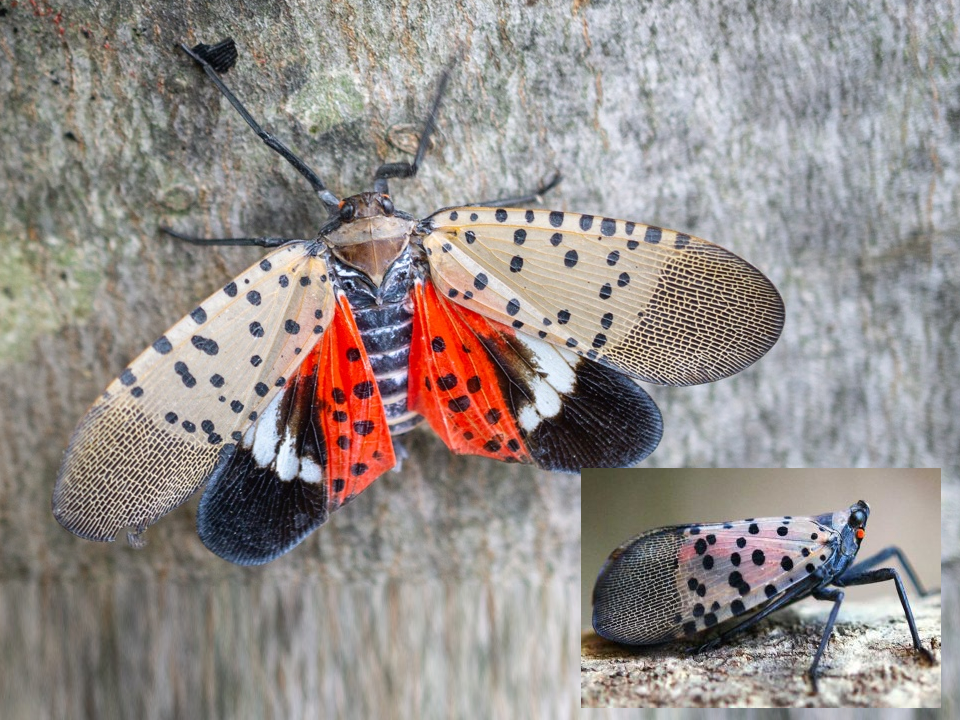The Spotted Lanternfly (SLF), Lycorma delicatula (White), is an invasive planthopper native to China, India, Vietnam. It was first discovered in Pennsylvania in Berks County and has spread to other counties in the southeast portion of the Commonwealth. This insect has the potential to greatly impact agricultural crops such as grapes, hops, and hardwoods. It is also reducing the quality of life for people living in heavily infested areas.
The invasive insect could wipe out about $18 million of the state’s wine, hardwood and fruit industries as the fly consumes fruit trees and makes them vulnerable to disease. As an indication of that, when the spotted lanternfly first entered South Korea, it overtook the entire country in under a year.
Since Pennsylvania is considered ground zero for this infestation, it has the responsibility of keeping it from spreading across the nation.
“This is a team effort and all hands are on deck,” Wolf said Tuesday on the property of the American Federation of State, County and Municipal Employees Council 13 headquarters in Swatara Township where the pest has been spotted. “[We are] committed to protecting Pennsylvania’s agricultural products, preserving our quality of life, and keeping commerce flowing here in the commonwealth.”
Those efforts have managed so far to keep the pest contained to just 14 of the state’s 67 counties.
What Is Being Done
Penn State University and Extension, United States Department of Agriculture (USDA), and PA Department of Agriculture (PDA) have joined forces to control and contain the spread of SLF. Penn State University is leading the research efforts currently underway to answer the many questions we have about the insect’s biology, pesticide studies, and the ability of the insect to adapt to the environment in Pennsylvania. USDA and PDA are actively treating locations where SLF has been reported. USDA is treating on the outer edges where the populations are small and will begin to move inward towards the center of the quarantine. PDA is treating areas where the population numbers are high and is targeting high risk pathways which may contribute to moving the insect to other locations. As funding is available, both USDA and PDA will work on properties for treatment. PDA is also surveying all counties in the state outside the quarantine looking for SLF.
What Can Be Done
Spotted Lanternfly can be controlled with a combination of physical removal of life stages and host trees, as well as pesticide applications. Penn State Extension has developed information for homeowner management as well as a management calendar. Use of these management techniques are important to assist PDA and USDA in control of the spread of this invasive pest. Businesses also play an important role. Business owners should incorporate pest management into their vegetation management plans and work to minimize the possibility of this insect hitching a ride on products they produce and ship. Businesses who ship products within and out of the quarantine zone are required to have or hire companies who have a Spotted Lanternfly Permit.
How You Can Help
This insect is easily moved if no one is looking. If you are in the quarantine area, please “Look Before You Leave” Inspecting your vehicles, trailers, or any outdoor items before you move around or out of the quarantine is important. If possible, don’t park in tree lines and keep windows rolled up when you park your vehicle. Know the life stages of the insect and when to look for them. Using the recommendations developed by Penn State Extension, take control measures on your own property. Any efforts you make in destroying the Spotted Lanternfly or it’s egg masses helps your property and community. Report sightings of the Spotted Lanternfly. All reports of SLF outside of the quarantine are taken seriously and will be investigated. Reports within the quarantine are registered in a database for USDA and PDA. The database is used to help determine properties for treatment. Treatment is based on location, risk, and available funds. Please join the effort to control and prevent the spread of Spotted Lanternfly. We need everyone to protect their properties, communities, and the Commonwealth from this invasive insect that has the potential to change our landscape and quality of life. Sources: https://www.agriculture.pa.gov/Plants_Land_Water/PlantIndustry/Entomology/spotted_lanternfly/Pages/default.aspx https://www.pennlive.com/news/2019/07/spotted-lanternfly-poses-serious-problem-we-need-your-help-pa-gov-tom-wolf.html

